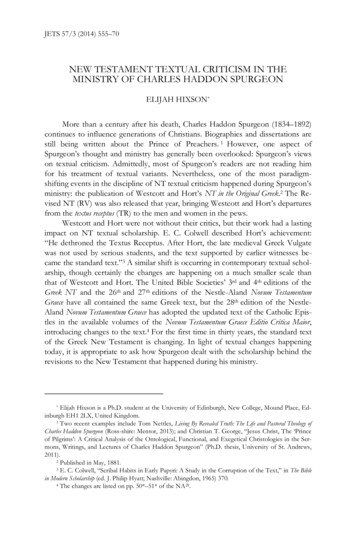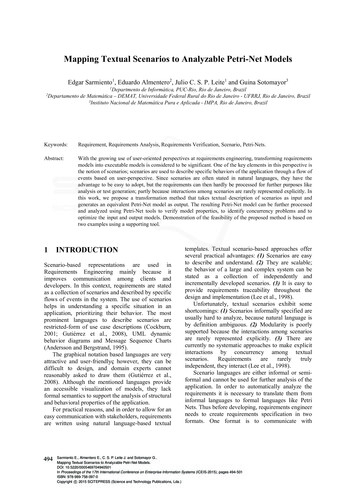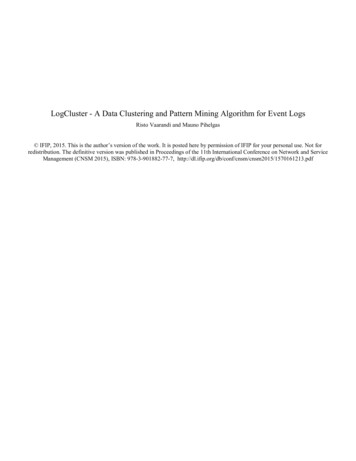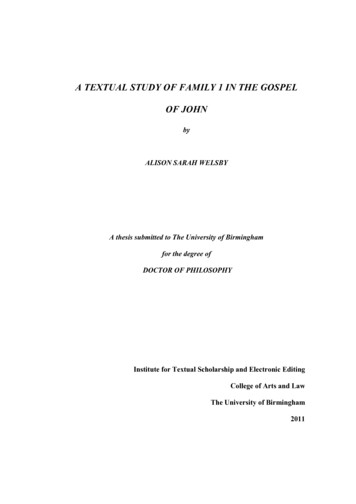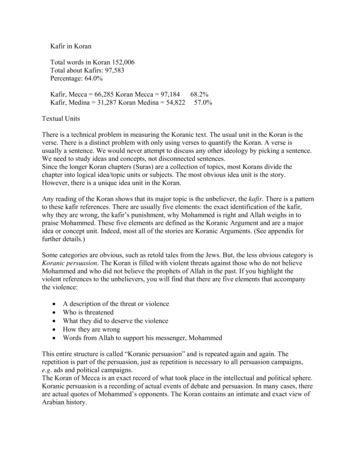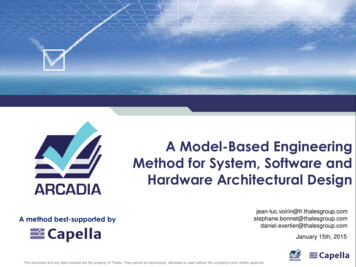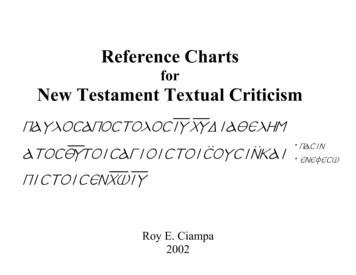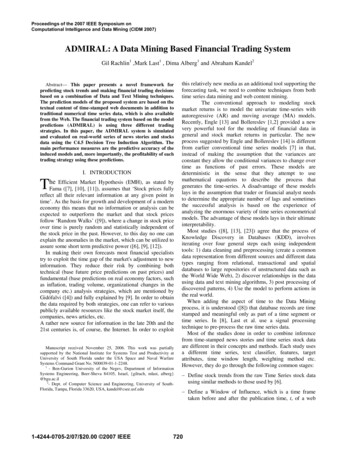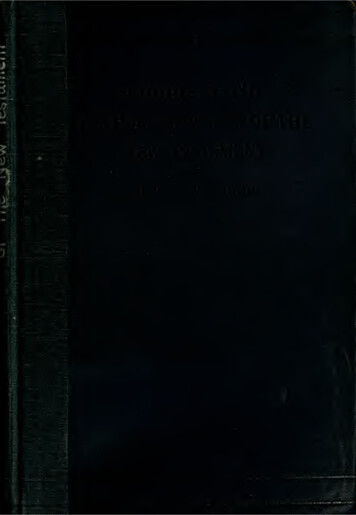
Transcription
f' .mn
TEXTUAL GUIDE.
ERRATA.Page2, line 20,PagePagePage3, line 9,9, line 20, r fl'Page13, line 21,rt' ffli'PagePagePagePagePagePagePagePage17, line 17,read7, line 2, r a !';15.its.affected yi?;* effected.manuscript yi?rnianusciipt .appeared yi?/- apeared. for .27, line 4, read Ano-xx for Asian.54, note 3,read56, note 2,?r« collating/ r collecting.ix.73, line 23, read93, note,7V 7rt 14/i?;' ii.14,The for That.contravened yi?;* controvened.95, line 6, 7rad 'Lwc v for Lucas.Page 121,Page iforwxw21, line 14, ;raa' manuscriptsy r manuscrij)!.Page 112, note2, read\\\\'.read the for3,line 20,readfor \.read Itacismt,yi?;-Italicism.128, line 23, ;rar/ authenticityy r authencity.
—AGUIDETO THETEXTUAL CRITICISMOF THENEW TESTAMENT.BYEDWARDMILLER, M.A.RECTOR OF BUCKNELL, OXON.OJ Xoyot''TruthMofohfit)TzafjkXQojai.— St.Matt.crushed to earth shall rise again. "GEORGE BELL ANDSONS,xxiv. 35.Bryant.YORK STREET,COVENT GARDEN, LONDON.1886.
CHISWICK press:—C.WHITTINGHAM ANDCHANCERY LANK,CO.,TODKS COURT,
TO THOSEWHO,WHETHER AT THE OUTSET OF THE WORK, OR AT THECLOSE,HAVE KINDLY GIVEN HELP OR ENCOURAGEMENT,CJisISlittle uatmGRATEFULLY INSCRIBED,WITH THE PRAYER,THATITMAY MINISTERIN SOME DEGREE,HOWEVER HUMBLE,TO THE ASCERTAINMENT AND ACCEPTANCEOFThe Genuine Words of Holy Scripture.
PREFACE.THEensuing treatise is intended to be a brief Manualon the Textual Criticism of the New Testament forordinary students of the Bible, and to induce those whomay bedisposed to enter more deeply into the importantit to prosecute further research in "The Plainsubject ofIntroduction"of Dr. Scrivener, the learned works ofDeanBurgon, and in other well-known sources of information uponTextual Criticism.Thefoot-notes will ordinarily indicatebeen indebted to the labours of otherpretends to bestoreslittlemore than ahow muchmenin a1 havework whichfaithful representation ofaccumulated by the learned, and an independentesti-mate of the conclusions drawn by them.TotheDeanof Chichester Ivious hints whichIamindebted forhave found invaluable duringcution of a task both laborious andtaking ofandIammemypre-prose-The underfrom without,myself convinced that some such assistance ashere offered to the general Readertime.difficult.was originally pressed uponitmanyButIlaydown my penfrom the accomplishment ofisgreatlyneededisat thiswith the conviction derivedmywork, that every Readerwho would really understand, and form an opinion for himself upon the great questions at stake, must bestow on theproblem which has suddenly emerged into prominence a
PREFACE.considerable amount of individual, unprejudiced attention.Hewillbe able to see with which of the contending partiesthe Truth mustcalm, judiciallie:spirit,but he must approach the problem in amust require Proofattainable) instead of puttingallmust never cease to exercise asagacity,My—in fact, ofProof(as far asisup with Hypothesis, and aboveCommonlargeamount ofvigilantSense.thanks are also due to the Rev. R. Hutchison, M.A.,Rector of Woodeaton, andOxford,who haslatekindly helpedScholar of Exeter College,mein correcting theproofsheets.E.BucKNELL Rectory,Eviber Week,Sept., 1885.M.
—s ' oJULl«M .OfficiiSf CONTENTS.CHAPTERImportance of the Subject.Introduction.Thequestion statedadvocated—theI.— seveninstances of serious changenumber introducedinto other editions — the subject— plan of the worknot generally— others also— moreRevised Versioninto theknown— importance ofitpp. 1-5.CHAPTER11.history of textual criticism.First Part.TheInfancycentuiy.—by investigation andnatural growth of the science influenceddiscoveryI.Earlier Stages.—I.:The New TestamentComplutensian Polyglott.Theodore Beza, and the Elzevirsnot printed2.Erasmus.3.pp. 6-7.thetillsixteenthRobert Stephen,— the Received Textpp. 7-12.—Childhood: Introduction of various readings, i. Bishop Walton,Codex A, Courcelles, and Fell.2. Mill.3. Bentley, CodexB.Bengel, Wetstein, Matthsei, Birch, Alter, and Moldenhawer.4.Griesbach, families and recensions of manuscripts, and Scholz5.the free advance of boyhoodpp. 12-19.II.CHAPTERIII.HISTORY OF textual CRITICISMSecond Part.III.Youth:{conthiued).Contemporary Growth.p. 20.— Impatience under an overwhelming mass of materials'
—CONTENTS.Extreme Textualism.Tregellesi.Lachmann— rejects— follows Lachmann — greatbut a few witnesses.alland editTischendorf— amazing labours— discovers the Sinaitic zigzagcourse.develop Lachmann's principles4. Drs, Westcott and Hort—extreme deference to B surprising results followed mainly by TwoMembers of the Revisers' Company must we follow them ? pp. 20-30.2.ing.services in collating—3,——IV. Signs of Coming Maturity——— Opposition,Dr. Scriveneri.:works— large-minded—Dean Burgon hisworks misrepresented — his sound and wide principles.3. CanonCook The Bishops Wordsworth, J. G. Reiche, Kuenen and Cobet,Dr. Michelsen, Vercellone, Ceriani, Abbe Martin other Romanhis . 30-37.IV.SCHOOL OF EXTREME TEXTUALISM.Theorigin attributedby the leading mastersA. Theory of Drs. Westcott and Hort.i.p.38B and n are the bestImportance of Genealogy, under which these two MSS. arederived from date and character a prior requisiteMSS.LachmanntoKnowledge of Documents2.:brought back nearly to the Apostolic autographs. 3. Four families,Syrian, made in a recension at Antioch, {h) Western, {c) Alexan-sc. (a)drian, and(fl ) Neutral,andshewn{bc)to beevidence.whichisthe best.4.Ofthese,two are corruptthe Neutral alone reaches back to earliest times;5.seldom wrongB.Refutation,Syrianpp. 38-44.i.Tooeasy to be true, grounded on only part ofthe evidence, and destitute of real proof.anxl;want of antiquity, and internalHence N B together nearly always right, and B aloneworthless by analysis,opinion unsupported by factsis2.Sound senseisviolated,balanced by opinions of otherGenealogy affords an unsafe analogy, and in fact pointsB and K are also condemned for want of descendants.The theory about Families is disallowed by other Doctors, and4,lacks evidence.5. The " Syrian," or Traditional Text, is not provedto be posterior, whether by an imaginary recension, or by a fancifultheory of conflation, or by ignoring proof of early existence, or by sup6. The characters of B and K not superfine ;posed internal evidence.nipsters.3.the opposite way.
—;CONTENTS.they were rejected by the Church, were the products of Semiarian times,arecondemned byexperts,and arefullof blundersCHAPTERpp. 44-59.V.THE RIVAL SCHOOL,Thetenets of theRival School already implied—i.They do notmaintain the Received Text, and are not indiscriminate in the use ofauthorities.2. Insist that all authorities should be weighed and em-and thus widen the basis. 3. They maintain the Traditionalwhich the Church of all ages has acknowledged, and no ageextreme importance of this part of the contentiontherefore can rejecthence the need of a history of the Traditional Text the questiondepends upon a just estimate of proportionpp. 60-64.ployed;Text,——.CHAPTER.VI.HISTORY OF THE TRADITIONAL TEXT TILL THE ERA OFST.CHRYSOSTOM.Difference between Sacred and Classical Textual Criticism,jecturalEmendation inadmissible.server as well as Inspirer of thewell as individual productions2.Godthe.Holyi.Holy GhostScriptures.3.Con-the Pre-Corporate aspp. 65-68.Early Corruption derived from oral teaching, tampering with the textby heretics, carelessness of scribes, ignorance of Greek or of doctrineGnosticism—— Marcion — Tatian —evidence of corruptionfaithful — Traditional.Exceeding care employed by theOld Latin Versions Egyptian—pp. 68-72.Text— Peshitopp. 72-77.— Origen — followers of Origen — Eusebius —persecution of— celebrated order of Constantine — transcription of B and NAlexandriaDiocletianPP- 77-83-Proofs of the Traditional Text in this period found amidst corruptionits subsequent supremacy,contemporaneous Versionsinin the.MSS.used by the Fathers, and inpp. 83-85.
—CONTENTS.CHAPTERVII.HISTORY OF THE TRADITIONAL TEXT FROM THE ERA OFCHRYSOSTOM TILL THE INVENTION OF PRINTING,The previous period anST.— the great Patristic Era— punctuation —breathingsTranscription — monasteries —era of speculationcommentaries, dictionaries, and grammars— improvementspellingibrariesinthe art of— canon of Holy Scripture— supremacy of the Traditional Textpp. 86-94.— Codex Alexandrinus (A) — Parisian Codex (C) — theFathers not uncritical — Uncialmanuscripts — Versions — VulgateArmenian — Georgian— Ethiopian — other Uncialspp. 94-100.Gothic Version.— their value— their agreement with the Uncials— Lectionaries —other Versions — undisputed predominance of the TraCursive manuscriptsTextditionalpp. 100-104.CHAPTERVIII.MATERIALS OF CRITICISM.I.{a)Uncial manuscripts—.in Gospels,Pauline Epistles, and Apocalypse(( )Cursive manuscriptsActs and Catholic Epistles,— their value and vast numberTable of Uncialspp. 105-106.pp. 106-107.pp. 108-109.— lectionary-system — theirinfluence in mischief— Evangelistaria — Praxapostoli — LiturgiesII.LectionariesandLiturgiespp.— Table—value Kirawbacks — Old Latin pp.Ecclesiastical Writers —drawbacks —value — the oldestIII. VersionsIV.manuscripts, but at second handThefield tobe explored— MSS.at firsthand wantingvalue110- II 2.113-115.classin antiquityp.CHAPTER"7.IX.PRINCIPLES OF CRITICISM.Noevidence must be discarded— responsibilityofofpp. 116-117.theChurch
—CONTENTS.I.Thefirst3.— begin with— and followed.object the discovery of the Traditional Textthe Received Text.All evidence must be mastered2.proof— seven canonsInternal Evidence not on a par with ExternalconclusionAppendixI.ThelastTwelve Versespp.118-122.of St. Mark's Gospelpp. 125-127.II.III.TheFirstWordThe Recordfrom the CrossThe Angelicpp. 127-128.of the strengthening Angel, the Agony,and the Bloody SweatIV.Hymn.pp. 128-130.V. The Doxology in the Lord's Prayerpp. 130- 131.pp. 131- 133.VI. The Son of God's Eternal Existence in Heavenpp. 133-134.VII.Godmanifested inThe Flesh.pp. 134-137.-
A GUIDE TO THE TEXTUAL CRITICISMOF THE NEW TESTAMENT.CHAPTERI.introduction.Importance of the Subject.WHATNewisthethe genuine Greek—whatWhichTestament ?the true Text ofare the very wordswhich were written by the Evangehsts and Apostles of ourLord Jesus Christ under the Inspiration of the Holy Ghost ?Have we upand used for the inforand the guidance of our lives a Formto this period receivedmation of ourfaithof Text, which in a vast number of particulars, many ofwhich are of great importance, has been fabricated by thedevice or error of men?This question has been raisedtimes,which has brought toresidinginancientcopiesTestament, that has ledin the research of recentlightandan amount of evidencetranslationsmany eminentof theNewscholars to reject, asbeing in their estimation corruptions of the pure Text,various passages which have endeared themselves to Christians in the course of centuries.Thus, according to prin-ciples largely adopted,(a)TheLast Twelve Verses of the Gospel according toB
INTRODUCTION.Mark must beSt.after the words,'cast aside,and an abrupt close madewerefor theyafraid.'In the Lord's Prayer as given by(b)St.the following clauses must be excisedwhich'ThyHeaven';inart—willLuke (xi. 2-4),Our .:—'be done, asinbut deliver us from evil.'Heaven, so on earth ;(c) The Doxology must be omitted from the Lord'sPrayer in St. Matthew (vi. 13), and so all record of it''lost in the Gospels.44 must no longer be reckoned in the 22ndSt. Luke, and thereby the account mustdisappear of the strengthening Angel and the Bloody(d) Vv. 43,chapter of'Sweat,' as well as the evangelical record of'theAgonyinthe Garden.'(e)The first of our Lord's seven Sayings from the CrossLuke xxiii. 34) must be regarded as unauthentic,Father, forgive them, for they knew not what they(St.*do.'Also(f)(xxiv.St.Luke's assertion of the Ascent into Heaven15),because—anomission ofthemore importance,Mark's account of the same event, whichSt.included also the session at the Rightsupposed under these principlestoHandofGod,ishave vanished withthe last twelve verses of his Gospel.(g)St.Luke's recital of the Institution of the Holy Sacra-mentisMy(xxii. 19,20) must belost,except as far as'ThisBody.'These seveninstances,which might be multipliedtensively by the addition of other omissions,—suchdescending angel and the cure wroughtinBethesda, of thelast cry in St.ex-as of thethe poolofMark's description of thecenturion's faith, of the greater part of St. Luke's account of
:RESULTS OF RECENT CRITICISM.theInscriptionon the Cross, ofPeter's visit to theSt.Sepulchre in the same Gospel, of the salutation'Peace beunto you,' of the Lord shewing His Hands and His Feet, ofthe word 'broken,' whereby a gashspaceleft in St.made andisa blankPaul's grand version of the Institution of theHoly Sacrament, and others too numerous to recount hereto do more than allude to startling statements, suchas that our Lord's Side was pierced before death, and thatmay teach all who reverethe sun was eclipsed at its full, and love the Word of God what precious points are atstake. If the changes advocated by the modern school leaveenough behind in Holy Writ to support without doubt the—not—of the Faithessentialsof Christendom, yetmomentous in themselvesas tothey aresoproduce a painful wrench inearnest affections which have attached themselves to wordsfamiliarand deeply loved from childhood, and to proveleast to firstthat, atappearance, general and special attention shouldbe directed to what maybe a corruption of the Holynumber of alterations, amountingmost moderate of the new recensions to 5,337,' revealsreallyScriptures. Besides this, thetheinthe formidable nature of the operations that are threatened.it must beone which presentsIf the majority of these alterations are small,rememberedmuch St.xxiv.St.that the instance takenislesschange than other editions of x.xv. 3924,iKkii-KovToq,:St.Luke/cXw utvorwhich, as:xxiii.St.New38:Testa-xxiv. 12:Matt, xxvii. 49Dean Burgontruly says("Revision Revised," p. 65), means an eclipse of the sun and no otherthing,' though the Revisers translate it *the sun's light failing.' The number of changes in the Greek Text of the Revised Versionas estimated by Dr. Scrivener (Burgon, "The Revision Revised," p.The changes in the English of the Revised Version are said to405).'amountto 36,191.
INTRODUCTION.Enoughment.the duty ofit isshownisto establishwhoChristians,allbeyond doubtrest in the controversies of their day, not tosuch concerns areYetsitstillat the present time there are comparatively few per-who have anintelligentacquaintancewith the grounds on which this important questionsubject atmost mindstoofull:first— thedemandItisfeaturesrests.sight presents a forbidding aspect toexceedingly valuable treatises onitareof learning, and too long for such as are not reallystudents to masterlifewhenin jeopardy.sons, clerical or lay,Thethattake an intelligent inte-:—anda simplertherefore withof Textualsiderationsasareand haste of modernthe hurrymodetheof treatment.hope of presenting the chiefCriticism,elementary con-suchorimmediately involvedthe Greek Text of theNewindeterminingTestament, to readersinaand not uninteresting way, that in deference to theurgent solicitations of some who enter deeply into thecontroversy, the composition of this little treatise has stians,whether they range themselves on the one side or the other,—must be the very expressions, the sentences, the phrases,of thethe words, and even the rhythm and the accents,genuine utterance of the Holy Spirit of God. The general—sentiment of Christianity has applied with plenary enlarge-ment the warning givenat the close of the lastBible against addition or omission.''Let noBookin theman addtoHoly Scriptures or detract anything fromone of the most renowned of the Fathers.'Letthe words of thethem,' said Rev.'Athanasius,'xxii. i8, 19."ExFestali Epistola," xxxix.(t.ii.p. 39, Eil,Colon).
OBIECTS OF THE TREATISE.themfear thewoe whichdestined for themiswho addto ortake away,' was the consentient admonition of another. Theleading points in the contention on either side willThebe given in the Narrative.questions in debate areand must be decided by the facts ofhistory, the origin and nature of the documents on whichthey depend, and due regard to the proportion of thequestionsofChristianFaith.fact,Theyattemptwill thereforebe settled piecemeal.must be before the court. AncannotAll the counts of the casebe now madeto represent with allcandour the chief grounds on which opinion should rest,as they have been set forth in the career of the Science ofTextual Criticism, in the principal arguments employed bythe Rival Schools of the present day, in the history of thetransmission of theNewTestament from age to age, and inand it will be our duty;the leading Materials of Criticismtodeduceinconclusion the main principles that ought toregulate critical operations in any endeavour to reviseremodel the Sacred Text. Tertullian,"Adv. Hennogenem,"xxiuand
——CHAPTERII.history of textual criticism.Earlier Stages, (i) InfancyFormaReceived Text.' (2) ChildhoodCritical Operations before 1830.First Part.:tion OF THETHE':Science of sacred Textual Criticismthe child ofiscircumstances, and has been fostered by the zeal andindustry of learnednumber ofmen.Ithasexisting Copies of thearisen fromtheNew Testament,largewhich hashas extended, reached no less than someThese primary sources of information arefurther augmented by Translations into various languages,and by quotations occurring in the works of early Ecclesiastical Writers.Accordingly, as these numerous witnessesnow, sofar as inquirytwo thousand. render evidence whichculars, thereisisplainly adiscordant in thousands of parti-need of guiding principles and of arecognised system in estimating their testimony.Thus theScience of sacred Textual Criticism has been gradually growing almost since the time of the invention of printing.Andaswas natural,itsgrowth and tendency have beenlargely influenced from time to timeby the materialsresearch and discovery have continually produced.new Manuscripts have been broughtthatWhento light, or the verdictof old ones has been ascertained by the slow process of col 2003.Burgon, **The Revision Revised,"p. 521.Dean BurgonDr. Scrivener, including these 374, reckons 2094." Plain Introduction," Appendix, p. xxx, 3rd edition.added 374in 1883.
THE INFANCY.the importationlation,of fresh evidence hasnecessarilyAscience de-effected the conclusions previously drawn.pending uponfacts thattractedprocessescomingto maturity.can be ascertained onlyafter pro-of investigation, cannot but be late inAt the presenttime,hundreds ofManuscripts are waiting to be collated, various Versionsneedre-editing,and indexes havequotations in the Fathers, beforealltobe provided of thethatistobe said uponcontroverted points can be collected with exact accuracy.Besides that, the relative value of the various classes andsubdivisions of evidence cannot yet be determined so as tomeet with universal acceptance.Four Periods in the history of Textual Criticism may bedistinguished, so far as it has been yet evolved, viz. Infancy,Childhood, Impetuous Youth, and Incipient Maturity.I.TheInfancy.Although a folio edition of the Bible in Latin was printedby Gutenberg as early as a.d. 1455, none in the originalGreek appeared till the beginning of the sixteenth century.The demandat the time was not great.Greek Scribesdependent upon employment for their living abounded inEurope after the capture of Constantinople in 1453. Print-would be much more difficult in the unfamiliar Greekand the prevalence of clever and graceful abbreviations made the work of copying at once more rapid andmore artistic. Therefore half a century passed by before theChurch saw the accomplishment of a task so formidable, ofwhich the want was at once so easily and so well supplied.ingtype:I. Cardinal Ximenes, founder of the University of Alcalk,and an eminent patron of literature, was first in the field. In
THE INFANCY.the course of his advancement he had passed from a dungeon,where he had spentsix yearsof his Hfe, to the ArchbishopricRegency of Castile; and in his later dayslaid out the vast income of his See upon charitable or publicobjects.Having collected together as many Manuscriptsas he could, he set Lopez de Stunica and other learnededitors to the work in 1502, on which he expended moreof Toledo and thethan 50,000 ducats, or aboutcommemoratethe birth;; 2 3,000.elapsed ere the completion of theand Latin on Jan.lishedtilltoTestamentinGreek1514; and the book was not pubXimenes' death, and did not get intotilltwo yearsThe Complutensianderived from the LatinsaidNewwas intendedBut many years10,1520, aftergeneral circulationItof Charles V.by the editorstoafter.name—such was thetitle,{Co?nplutu?i) of Alcalk—wasPolyglottforhave been constructed from selectedManuscripts of great age and accuracy, supplied by PopeLeoX.,who wasthe patron of the undertaking.Attemptshave been made without success to ascertain what theseManuscripts were.Theonly resultisthatwe must abide bythe assertion of the editors and the character of the work.The Complutensianmeansisadmitted to be abut not by anyhad already beenupwards of a thoufaira faultless edition of the text thatin vogue, asisuniversally admitted, forsand years.2.But the Complutensian Polyglott was actually anticiin Germany.pated in publication by a Greek TestamentFroben, the printer of Basle, hearing of the operationsSpain, and wishing to forestall them, sent to Erasmus,was then stayingundertake theininwhoEngland, and pressed him earnestly tooffice of editor.overtures on April 17, 15 15.Erasmus received thefirstBut such was the haste made
THE COMPLUTENSIAN AND ERASMUS.that theNew9Testament was printed before the end ofErasmus had however, as it appears, madesome preparations of his own before he heard from Froben.February, 15 16.Heseems to have used what copies he could procure, butwhere he either found or supposed his Greekin a few casesauthorities to be deficient,he translated from the Vulgateinto Greek. Erasmus'firsteditionmadeitswayinto Spain,where theCoraplutensian was lying complete, but awaiting the Pope'simprimatur for publication.the spirit of rivalry*Wouldbetterif:Stunica found fault withthat all the Lord's peoplethou canst;itinbut the fine old Cardinal replied,condemn notwere prophetsproduce!the industry of another.'Erasmus was, however, attacked by Stunica, andalso byEdward Lee, afterward Archbishop of York, because he hadomitted the testimony of the heavenly Witnesses in i John v.7, as well as on other grounds. Erasmus rephed that he couldnot find the passage in his Greek manuscripts, and thateven some Latin copies did not give it. But at length hepromised thatifany Greek manuscripts were producedcontaining the words, he would in future insert them.Codexremarkable that the celebrated Vaticanonthisoccasion for thefirst(B)It iswastime appealed to on a point ofIn course of time the Codex MontforDubHn, was brought forward, and in consequence the passage was printed by Erasmus in his thirdtextual criticism. tianus,nowatedition in 1522.parallelsion of the latter'Afourth edition exhibited the text in threecolumns, the Greek, the Latin Vulgate, and a recen-by Erasmus.This was notably the caseThelast inin the last six verses Scrivener's "Plain Introduction," p. 431. Tregelles," Printed Text,"p. 22.1535 containedof the Revelation.
THE INFANCY.Each successiveonly the Greek.edition underwent cor-rection, but the last did not differErasmus died3.Themuch fromthe fourth.at Basle in 1536.editions of Robert Stephen,Theodore Beza, andthe Elzevirs, complete this period.The twofirstof Stephen, published at Paris respectively1546 and 1549, were most elegantly printed with typecast at the expense of Francis L, and are known to connoisinseurs by thetitle'Omirificamfrom the opening words ex-'encomium upon thatcame out in 1550, andpressing anking's liberality.in folio,for the firstThethird,time in thehis-tory of editions of the Greek Testament contained variousreadings.Reference wasmadeto sixteen authorities, viz.,and fifteen manuscripts,amongst which the Codex Bezae (D), now at Cambridge, isthought to have been numbered.' Erasmus is not mentioned,theComplutensianPolyglottalthough Stephen's two earliest editions were mainly groundedupon Erasmus' readings;andhis third, according to Dr.Scrivener's computation, differs from361himself, butthem conjointlyRobert Stephen did notplaces."- employed theHis record of readingsinonlycollate his authoritiesservices of his son Henry.in themargin of hisfoliocausedand StephenHere he pubwithdrew to Geneva to escape their enmity.lished in 1 55 1 his fourth edition, almost unchanged in theGreek text from the previous one, but with one remarkableThe chapters, into which Cardinal Hugo, ofalteration.great offence to the doctors of the Sorbonne,Santo Caro, had divided the books of the Bible in thethirteenth century, were in this edition'-firstsubdivided intoScrivener, "Plain Introduction," pp. 121, 438." Plain Introduction,"in punctuation.p.436;i.e.,334 timesin the text,and 27
"'STEPHEN, BEZA, THE ELZEVIRS.iiHis son Henry said that his father made the sub'whilst riding' from Paris to Lyons, probablyverses.divisionduring the intervals of his exercise.referencefacilitateHis object was toa Concordance which he hadininprospect. Beza's text did not differmuch fromlished five editions, slightly varyingranging from 1565 to 1598.Ofproducedfifthhaving beenBesides the advantage of'extreme old age.'inpub-these the fourth, published1589, has the highest reputation, theinHeStephen's.upon one another, andStephen's collections, Beza was the possessor of two veryMSS., the one already mentioned (D of theimportantGospels and Acts), which was presented by him to theCodex ClaromontanusUniversity of Cambridge, andthe(D ofParis,Epistles)Paul'sSt.tained Greekand Latinatboth of which con-being o editionsother in— BonaventureTheir text was1633.Stephen and Beza.the expression'TheReceived Textreceived,in'one—broughtin 1624,made up fromlatter editionAddressing the reader theyuniversallyand Abrahamat their celebrated press,'those ofwas remarkable fromoccurring for thesaid,outand thefirsttime.So you have now atextwhich we give no alteration orcorruption.'Thetext of Stephen,which was afterwards carefully repro-Dr. Gregory however (" Prolegomena," pp. 164-66) maintains that Stephen Langton was the author ofSome sort ofthe present division into Chapters, as usual in the West.division had been in existence from the first (Ibid. pp. 140-163). Textum ergo habes nunc ab omnibus receptum, in quo nihilimmutatum aut corruptum damus,' referring to the edition of 1624. This'(Pref.)isthe ordinary account.
THE CHILDHOOD.12duced byMill, hasstandard or'been generally takenReceived'text,andThebeen thus regarded on the continent.any one of the chief editions. at variance, they sometimeswerethe'as thetranslators,how-our Authorized Version did not adhere exclusivelyever, oftoEnglandinthat of the Elzevirs hasReceived TextWhentheir authoritiesin their interpretation offollowed Beza, sometimes Stephen,'Erasmus, orsometimes the Complutensians,theLatinVulgate.11.The Childhood.In the period hitherto indicated, there was hardly anyweighing of opposed readings. Such as presented themselveswere ordinarily accepted with impHcit confidence. The freeinstincts of infancy guided the Science mainly along a trackhad previously been trodden with the continued approvalIt would be reckless haste,would off-hand condemnthatnot discerning judgment,thatof the Church for centuries.resultsthusknowntoreached.Thecopiesbe specimens more orpreserved in the Churchaschieflyless exactthefollowed wereof what had beenrecognised form of theinspired Word."The Received Text'of thesixteenthand seventeenthDr. Scrivener has collected 252 passages, out of which the transBeza against vStephen in 113, Stephen against Beza in 59,lators followthe Complutensian, Erasmus, or the Vulgate against both Stephen and"The Authorized Edition of the English Bible," &c.,Beza in 80.—by F. H. A. Scrivener, M.A., D.C.L., LL.D., Cambridge, 18S4,Appendix E.2 This is acknowledged by both the Rival Schools of the present day.See Westcott and Hort, "Introduction," pp. 91, 92, no, 142, 145,Burgon, "The Revision Revised,"Vol. i., pp. 547, 550, 551.146.pp. 257, 258.
RECEIVED AND TRADITIONAL TEXTS.13centuries represented with general, but far from invariableaccuracy, the Traditional Text of the previous ages of theChurch.But, on the other hand, theChurch ofcould not properly rest without ascertaining, byand deep inquiryaslateralltimessuch widewas possible, whether these instinctiveprocesses had issued in well-grounded conclusions.Whatwould be proved to be right in full and free investigation, if candour and largeness of mind and firmness infaith kept away prejudice and narrowness and unbelief.I. In 1657, Brian Walton, afterwards Bishop of Chester,published a Polyglott, to which were appended some variousIn companyreadings both in the fifth and sixth volumes.with some colleagues he had devoted himself to this workfor twelve years during the dark troubles that had befallenthe Church of England. He included various readings fromwasrighttheCodex Alexandrinus(A),nowMuseum,in the Britishwhich had been presented by Cyril Lucar to Charlesin 1628.There were comprised inI.his pages also the resultsof collations of sixteen Manuscriptsmade by ArchbishopUssher.In the next year apeared at Amsterdam a New Testamentby Curcellaeus or Courcelles, marked by Socinian tendencies.And soon after, in 1675, Dr. John Fell, Bishop of Oxford,published a small edition, in which collations from freshManuscripts were given, and citations were added from theMemphitic or ancient Version of Lower Egypt, and themade soon after the Goths settled on theGothic,
AGUIDE TOTHE TEXTUALCRITICISM OFTHE NEWTESTAMENT. BYEDWARDMILLER,M.A. RECTOROFBUCKNEL


